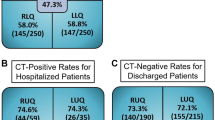Abstract
To determine the benefit of a short-term follow-up abdominopelvic computed tomography (APCT) examination among emergency department (ED) patients with persistent abdominal pain and an initially negative CT. During a 5-year period from January 2004 to December 2008, our institution’s radiology department performed approximately 56,000 APCTs examinations in the ED. Sixty-eight percent of the APCT examinations used intravenous contrast. Nine hundred fifty-seven patients received two APCTs within 1 week for non-traumatic abdominal pain in the ED. Sixty-four patients with initially negative APCTs presented to the ED within 1 week with persistent abdominal pain and received follow-up APCT imaging. The mean follow-up period was 2.6 days. The mean interval period in which the second APCT yielded a positive result was 2.0 days. Seventy-five percent of follow-up examinations were performed with intravenous contrast. Twenty-three percent of patients had positive findings on the follow-up examination. Seventy-three percent of the follow-up positive findings were referable to bowel pathology. The cause of abdominal pain remained elusive at 1 week in 23% of patients. Short-term follow-up APCT examinations in patients with persistent, unexplained abdominal pain may be of benefit if the second APCT is performed with intravenous contrast in patients suspected of having bowel pathology.


Similar content being viewed by others
References
Rosen MP, Siewert B, Sands DZ, Bromberg R, Edlow J, Raptopoulos V (2003) Value of abdominal CT in the emergency department for patients with abdominal pain. Eur Radiol 13:418–424
Paulson EK, Jaffe TA, Thomas J, Harris JP, Nelson RC (2004) MDCT of patients with acute abdominal pain: a new perspective using coronal reformations from submillimeter isotropic voxels. AJR Am J Roentgenol 183:899–906
Gore RM, Miller FH, Pereles FS, Yaghmai V, Berlin JW (2000) Helical CT in the evaluation of the acute abdomen. AJR Am J Roentgenol 174:901–913
Ahn SH, Mayo-Smith WW, Murphy BL, Reinert SE, Cronan JJ (2002) Acute nontraumatic abdominal pain in adult patients; abdominal radiography compared with CT evaluation. Radiology 225:159–164
Chambers A, Halligan S, Goh V, Dhillion S, Hassan A (2004) Therapeutic impact of abdominopelvic computed tomography in patients presenting with non-specific acute abdominal symptoms. Acta Radiol 45:248–253
Tsushima Y, Yamada S, Aoki J, Motojima T, Endo K (2002) Effect of contrast-enhanced computed tomography on diagnosis and management of acute abdomen in adults. Clin Radiol 57(6):507–513
Riddell AM, Khalili K (2006) Assessment of acute abdominal pain: utility of a second cross sectional imaging examination. Radiology 238(2):570–577
Harvey RT, Miller WT (1999) Acute biliary disease: initial CT and follow-up US versus initial US and follow-up CT. Radiology 213:831–836
Author information
Authors and Affiliations
Corresponding author
Rights and permissions
About this article
Cite this article
Asrani, A.V., Johnson, JO.F. & Novelline, R.A. Benefit of follow-up CT in emergency department patients with persistent non-traumatic abdominal pain. Emerg Radiol 18, 5–9 (2011). https://doi.org/10.1007/s10140-010-0893-8
Received:
Accepted:
Published:
Issue Date:
DOI: https://doi.org/10.1007/s10140-010-0893-8




